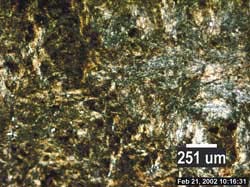Materials Sciences
Materials management deals with the research, development, manufacturing and processing of raw and industrial materials. Key aspects here are biological and medical issues, which play an increasingly important role in this field.
innovations-report offers in-depth articles related to the development and application of materials and the structure and properties of new materials.

Researchers develop nanoscale fibers that are thinner than the wavelengths of light they carry
Researchers have developed a process to create wires only 50 nanometers (billionths of a meter) thick. Made from silica, the same mineral found in quartz, the wires carry light in an unusual way. Because the wires are thinner than the wavelengths of light they transport, the material serves as a guide around which light waves flow. In addition, because the researchers can fabricate the wires with a uniform diameter and smooth surfaces down to the atomic level, the light waves remain coherent as they

Tiny nanowire could be next big diagnostic tool for doctors
A tiny nanowire sensor — smaller than the width of a human hair, 1,000 times more sensitive than conventional DNA tests, and capable of producing results in minutes rather than days or weeks — could pave the way for faster, more accurate medical diagnostic tests for countless conditions and may ultimately save lives by allowing earlier disease detection and intervention, Harvard scientists say.
In preliminary laboratory studies demonstrating the capability of the new sensor, the researchers

Standard helps control quality of joint replacements
Ionizing radiation isn’t generally thought of as good for you, but it’s good for artificial hips. A new reference material from the National Institute of Standards and Technology (NIST) will help researchers determine what methods of irradiating the plastic parts in joint replacements during manufacturing will best increase their wear resistance.
Reference Material 8457 is intended to help address concerns about the long-term durability of orthopedic hip implants amid growing use

Rice engineers make first pure nanotube fibers
Discovery could allow industrial production of cables, sheets of pure carbon nanotubes
Researchers at Rice University have discovered how to create continuous fibers of out of pristine single-walled carbon nanotubes. The process, which is similar to the one used to make Kevlar® on an industrial scale, offers the first real hope of making threads, cables and sheets of pure carbon nanotubes (SWNTs).
The research is available online today from the journal Macromolecules.

A hot time for cold superconductors
A new way to manufacture a low-cost superconducting material should lead to cheaper magnetic resonance imaging machines and other energy-efficient applications, say Los Alamos National Laboratory scientists.
Hot isostatic pressing of wires made of magnesium diboride, or MgB2, significantly increased the amount of electrical current the wires can carry without electrical resistance. Wires made from MgB2 would reduce the costs of such products as MRIs and electrical generators, say the researc

Tiny ’nanofingers’ to support sensors, other applications
Future sensors may take the form of microscopic finger-like structures developed at Ohio State University.
Engineers here have found an easy way to carve the surface of inexpensive ceramic material into tiny filaments, creating a platform for devices that detect chemicals in the air. They could also be used to clean up toxic chemicals or gather solar energy, or to form fog-free or self-cleaning surfaces.
Each filament, or “nanofinger,” consists of a single crystal of the com